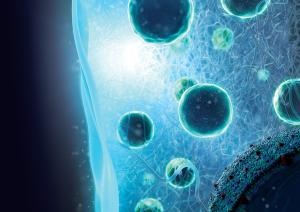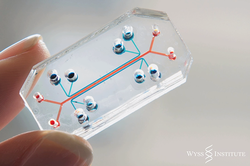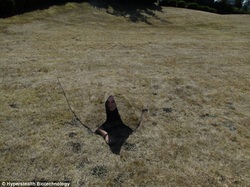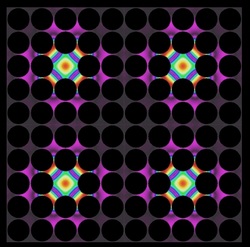
An artist's impression of light-sensitive cells encapsulated in an implanted gel (Image: Harvard Bio-Optics Lab)
Light can now be used to heal diabetes in mice. By implanting a transparent gel that contains genetically modified light-sensitive cells, researchers have demonstrated a new type of implant that could one day be used to treat disease and monitor toxins in people.
"Light is a great tool to interface with biological systems, but there is a fundamental problem. It gets scattered when it hits tissue, and at depths much thinner than our skin," says lead author Myunghwan Choi of Harvard Medical School in Boston.
A father who was given a high-tech bionic hand after losing his arm in an accident six years ago yesterday claimed he can now tie his shoe laces again. Nigel Ackland, 53, was fitted with the Terminator-like carbon fibre mechanical hand which he can control with movements in his upper arm in November last year. The bebionic3 myoelectric (double corr) hand, which is also made from aluminium and alloy knuckles, moves like a real human limb by responding to Nigel's muscle twitches. Incredibly, the robotic arm is so sensitive it means Nigel can touch type on a computer keyboard, peel vegetables, and even dress himself for the first time in six years.

Combining microfabrication techniques with modern tissue engineering, lung-on-a-chip offers a new in vitro approach to drug screening by mimicking the complicated mechanical and biochemical behaviors of a human lung.

The U.S. military is backing the development of camouflage fabrics that could one day make soldiers completely invisible.
The so-called 'Quantum Stealth' camouflage material is said to render its wearers completely invisible by bending light waves around them.
Its makers claim the material, which is in effect similar to the invisibility cloak worn by Harry Potter, can even fool night-vision goggles.
The material renders the target completely invisible by bending light waves around the target. It removes not only your visual, infrared (night vision) and thermal signatures but also the target’s shadow.

Thermal lattices, shown here, are one possible application of the newly developed thermocrystals. In these structures, where precisely spaced air gaps (dark circles) control the flow of heat, thermal energy can be "pinned" in place by defects introduced into the structure (colored areas). Illustration courtesy of Martin Maldovan
An MIT researcher has developed a technique that provides a new way of manipulating heat, allowing it to be controlled much as light waves can be manipulated by lenses and mirrors.
The approach relies on engineered materials consisting of nanostructured semiconductor alloy crystals. Heat is a vibration of matter — technically, a vibration of the atomic lattice of a material — just as sound is. Such vibrations can also be thought of as a stream of phonons — a kind of “virtual particle” that is analogous to the photons that carry light. The new approach is similar to recently developed photonic crystals that can control the passage of light, and phononic crystals that can do the same for sound.